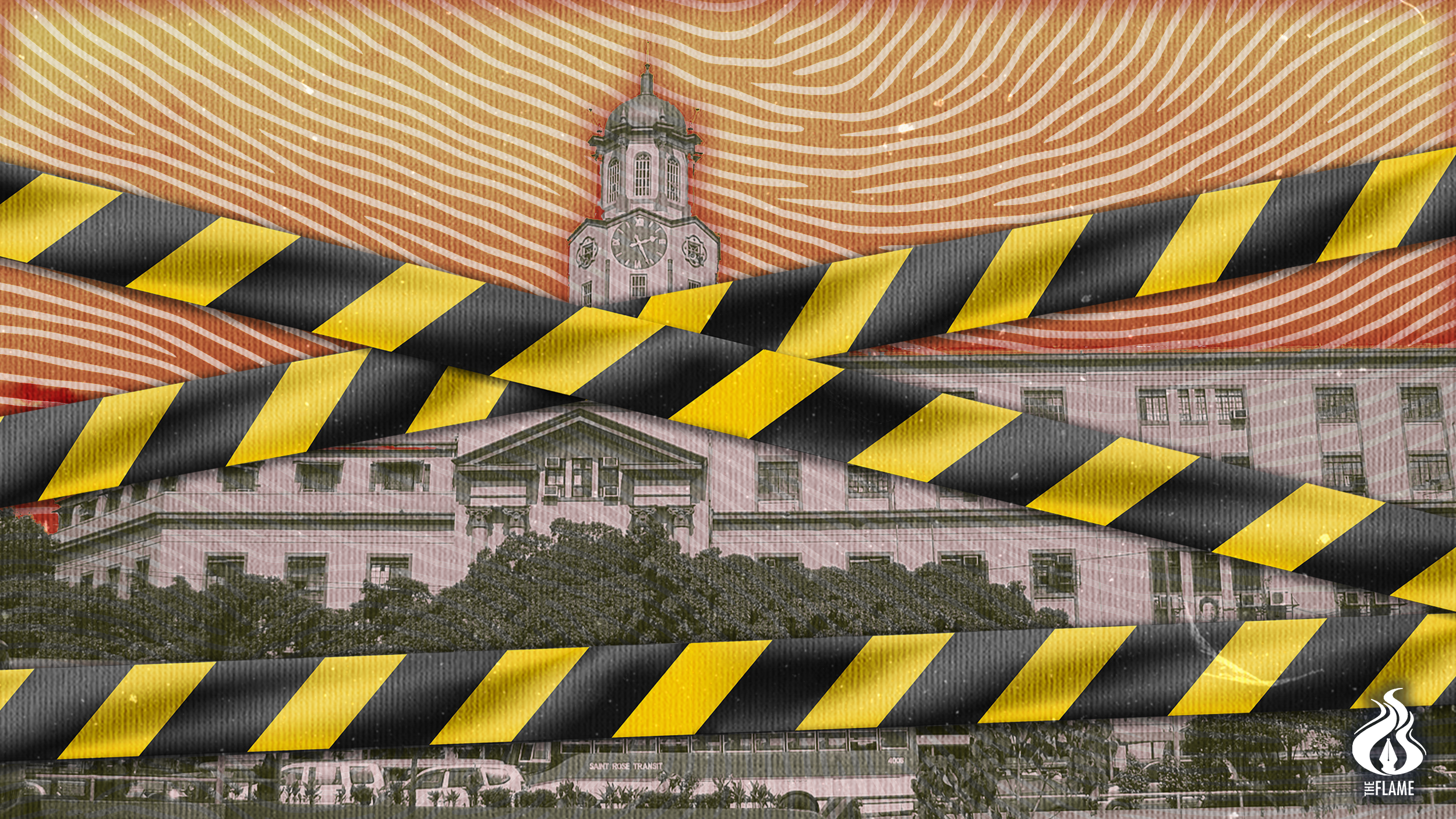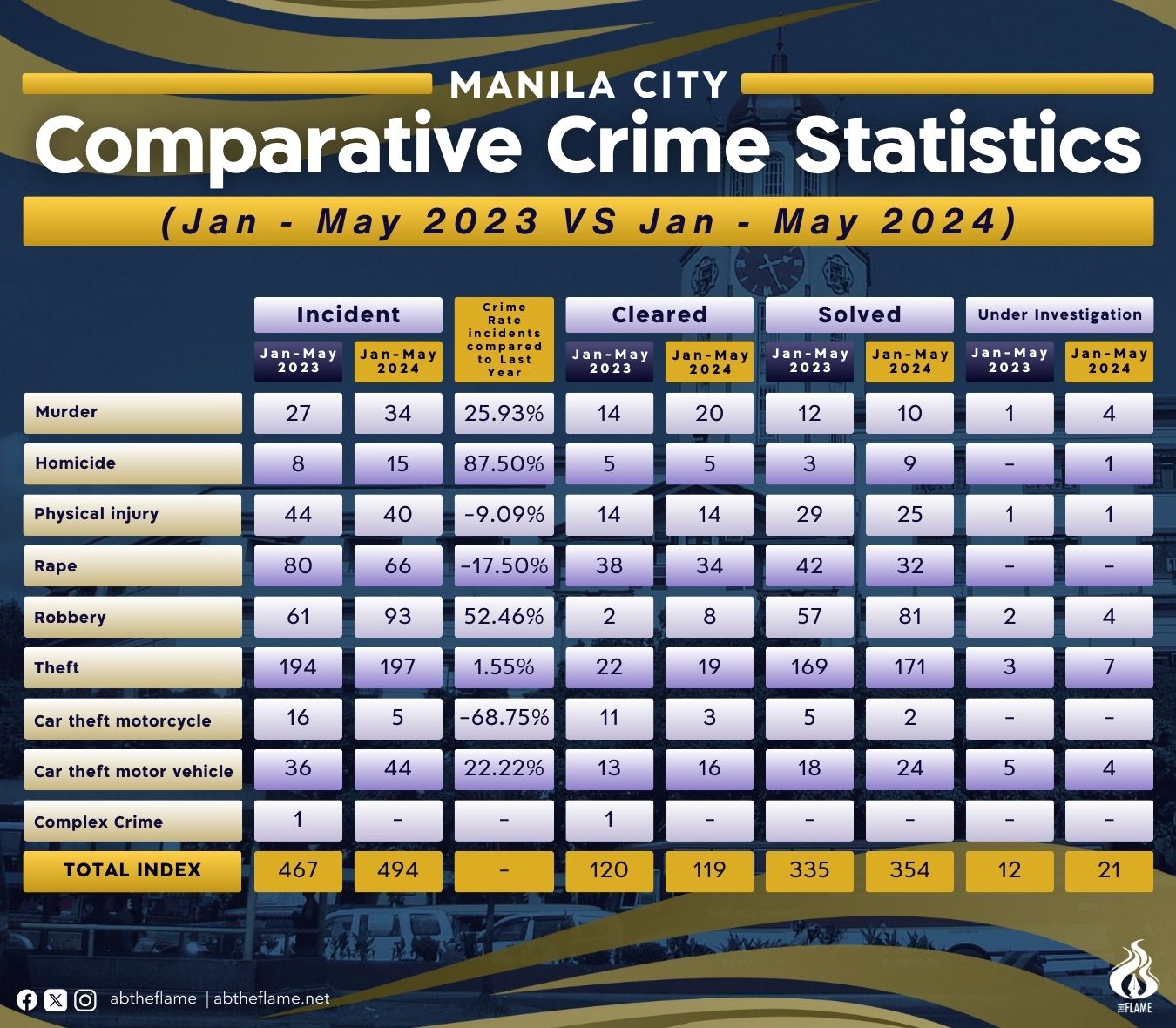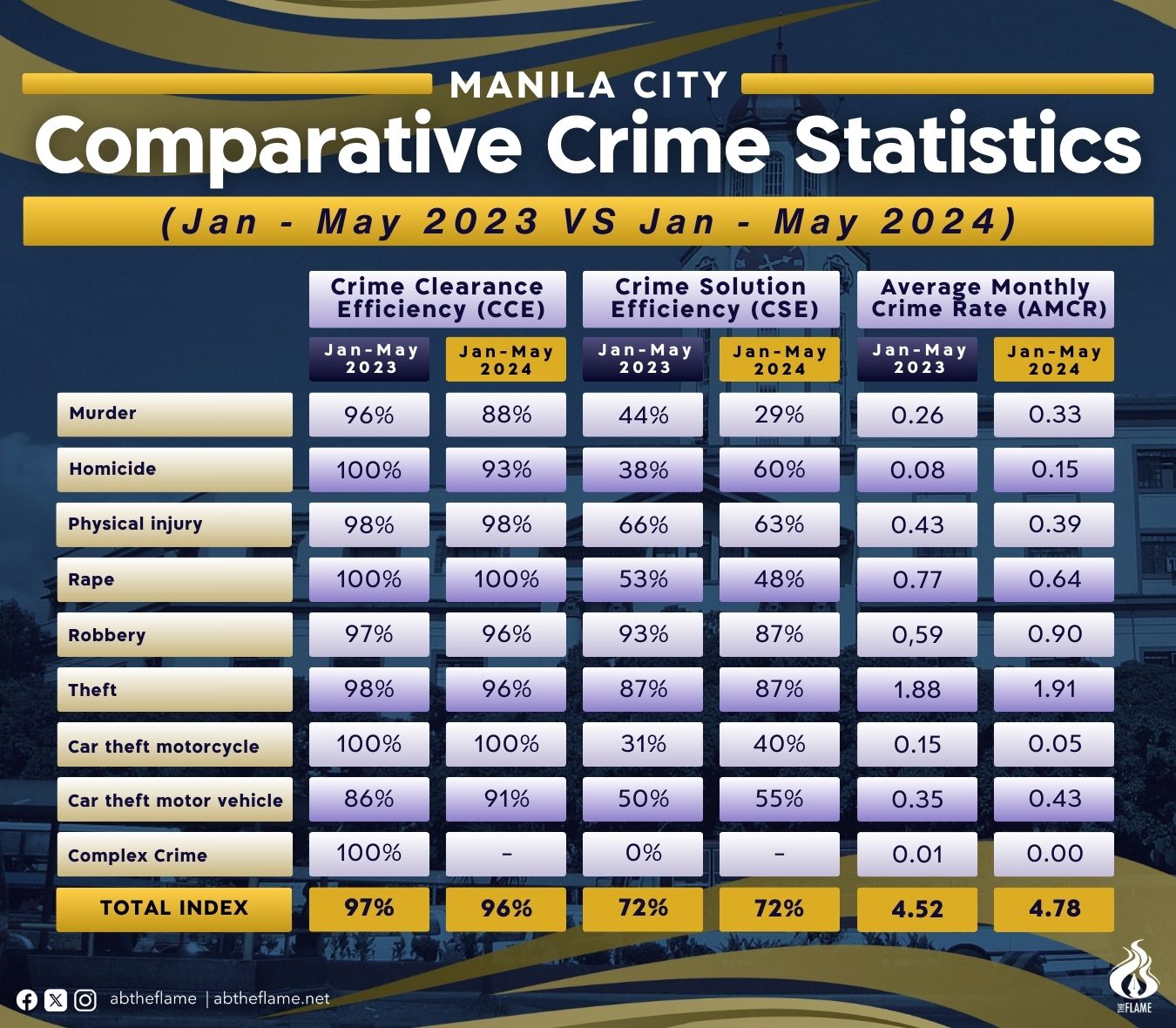
ALMOST A year ago, the images of saints in a store in Manila became silent witnesses of an act forbidden both by the heavens and by civil authorities.
A Thomasian was searching for coins in her wallet beside a store selling religious articles in Tayuman when it was suddenly snatched from her.
It was about four o’clock in the afternoon in December 2023 when the incident happened to Industrial Design freshman Adriana Martinez, who was waiting for a jeepney bound for Abad Santos. She did not see what the perpetrator looked like.
“I didn’t proceed [reporting the crime] because [I] lack[ed] information or details on the snatchers’ facial recognition,” Martinez said.
Her wallet contained P600, IC or integrated circuit cards that were used to pay for public transportation and shops in Japan and a timezone card. While shocked by her experience, Martinez did not dwell too much on the theft since only the cash was valuable to her.
According to police data, theft remained the most frequent index crime committed in Manila in the first five months of 2024 even if some incidents, such as that of Martinez, were not recorded.
While latest official statistics showed a drop in index crimes or those that are directed against persons and properties, concerns persist over the safety of streets in the capital city, including those around UST.
However, such concerns cannot be addressed if authorities are not informed about illegal activities, the police said.
“How can we catch these people if no one is reporting?… We can’t just guess. What we need here is for you (students) to report,” Manila Police District (MPD) spokesman Police Maj. Philipp Ines told The Flame.
“When you report such incidents, you do not only help yourself but also prevent others from becoming victims,” he added.
Ines said criminals would become bolder in committing illegal activities if they do not face the consequences of their actions.
“Let’s not always put it (crime prevention) on the shoulders of your authority. It is also your obligation that if you see anything suspicious, report it,” the MPD spokesman added.
What the figures say

A total of 494 index crimes were recorded in Manila from January to May 2024, lower by about 5.8 percent from 467 incidents in the same period last year, according to MPD data obtained by The Flame.
Index crimes include the eight focus crimes or severe incidents occuring frequently, namely theft, robbery, murder, homicide, physical injury, rape, car theft and motorcycle theft.
Theft and robbery topped the list with 197 and 93 cases, respectively. They were followed by rape (66), motorcycle theft (44), physical injury incidents (40), murder (34), homicide (15) and vehicle car theft (5).
Ines said the high number of students in the University belt or “U-belt” area and the perception that they are “wealthy targets” contribute to the rise of criminal incidents.
“There are many students there (U-belt area). And… their families have enough money to send their children to school,” he said.
“Even students from the provinces…came from a well-to-do family because [they] can’t study there if [their] parents don’t have money.”

The crime clearance efficiency (CCE) rate from January to May 2024 was at 96%, down by one percentage point from last year.
The CCE rate refers to the percentage of cases that have been cleared out of the total reported crimes. An incident is considered “cleared” if at least one of the offenders has been identified and there is enough evidence to file charges against that person.
Meanwhile, the crime solution efficiency (CSE) in Manila was at 72% during the first five months of the year. The CSE refers to the percentage of solved cases out of the total number of crime incidents. The police regards a case as “solved” if the evidence against the offender is sufficient and the culprit has been identified, taken into custody, and charged. Solved cases are also included in the CCE rate.
A notable decrease in CCE was recorded in murder and homicide incidents.
Murder cases’ CCE dropped by eight percentage points to 88% from last year’s 96%, while its CSE decreased by 15 percentage points to 29% from 44%.
With regard to homicide cases, the CCE decreased by seven points from 100% to 93% but its CSE improved from 38% to 60%.
For rape cases, the CCE remained at 100% as of May while the CSE decreased from 53% to 48%.
The average monthly crime rate slightly increased to 4.78% from 4.58% during the same period in 2023. The rate is calculated by dividing the total number of reported crimes by the population and then multiplying it by 100,000.
Based on the 2020 census of the Philippine Statistics Authority, the total population of Manila is about 1,846,513.
Criminal incidents near UST
The nearest police station to UST is the University Belt Area Police Detachment, which is under the jurisdiction of Barbosa Police Station along Padre Noval and Reten Streets. The station is about 500 meters away from the University.
MPD showed that the Barbosa Police Station recorded 28 incidents from January to May this year, compared to 27 during the first five months of 2023.
The Sampaloc Police Station, which is about 3.4 kilometers from UST, logged 47 incidents as of May from 51 last year.
Horror stories
Legal Management student Chloe Sophia Laurante felt unsafe when a man accused her of breaking his vaping device along G. Tolentino and Delos Reyes streets. The man demanded that she pay P900 for the broken device.
Laurante denied the allegation and was able to avoid paying the amount since their exchanges had already caught the attention of bystanders.
While she was spared from the scam, Laurante was too traumatized to report it to the police.
“The streets outside the [campus] are not safe for students. Even though there are a lot of people walking every day and every hour, any individual is still prone to such modus and crime,” she said.
Advertising Arts sophomore Shane Sapitan also felt unsafe in the alleys of Padre Noval and Dapitan streets.
“When it comes to the inner streets, I feel like I could get assaulted because of the demeanor of some locals,” Sapitan said.
“There are no guards patrolling the inner portion of the streets, so it’s a lot more dangerous.”
According to Sapitan, only the streets near the campus have security.
“I only feel relatively safer around the ‘walls’ where UST still has line of sight,” Sapitan said.
But these concerns are not new as some Thomasian alumni had similar experiences in the area.
History alumnus Jolo Ricaplaza recalled an incident in 2014 when five men suddenly followed him and his friends along Lacson Avenue in broad daylight.
Ricaplaza and his three friends, two of whom were female, were returning to the University via Lacson Gate.
He said five brawny men, whom he said resembled goons in the highly popular action series Batang Quiapo, were glaring at them and following their movement.
“You don’t want to judge them, but they looked at us differently. Nanlilisik ‘yung mata eh (Their eyes were glaring),” he said.
One of them had a sling bag, and Ricaplaza suspected that he would take out a knife any minute.
“Thankfully, my male friend and I were able to communicate by doing eye signals. We knew right away that our two female friends would go with him, while I would separate from them. It’s like I’m the decoy,” he said.
They eventually managed to move toward a nearby tricycle terminal for their safety and evaded the group that followed them.
“When we looked back, the five men disappeared,” Ricaplaza, who was a freshman at the time, said.
Years later, he experienced an incident involving a sweaty, out-of-breath man who approached him and attempted to sell him an iPhone. It happened about 8 p.m. or 9 p.m. when he exited UST through the Beato gate. The man tried to sell him the phone for P6,000.
“So [I] knew right away that the iPhone was newly stolen…He immediately offered it to me…because he was out of breath. Bagong snatch ‘yun, malamang (It was newly snatched, for sure),” Ricaplaza stated.
UST campus safety and security office director Asst. Prof. Juliano Parena, Jr. gave an assurance that the University has a team tasked to deal with such incidents.
“When a crime is reported, our officers respond immediately to secure the scene and assist the victim. We have a dedicated response team trained to handle various emergencies,” Parena told The Flame.
“Our officers then coordinate with the proper office that would be able to provide support services such as counseling, medical assistance, and coordination with law enforcement,” he added.
Aside from support services, the office can also provide updates on the investigations.
Negligence
Ines said criminals take advantage of the lack of security in some areas to commit unlawful acts.
Recalling interrogation sessions with arrested persons, the MPD spokesman said some claimed that they committed crimes because students were “careless” with their belongings.
“We can see that there is also negligence on the part of the students. Sometimes cellphones [or wallets] will be placed in the back of the bag,” Ines said.
Criminals also seize the opportunity in some student dormitories and condominiums since some occupants leave their doors unlocked.
“[Criminals] pass by and take advantage of it. Kaya nasasalisian [ang mga estudyante],” Ines said.
Some people also leave their gadgets in spots where they can be stolen easily, like areas near windows, he added.
According to Ines, crimes happen because of the presence of the factors of the “triangle of crime,” namely the victim, the opportunity, and the desire to perform the act. He said a crime would not occur if one factor is missing.
“[If] there is an opportunity [and] a person to do the act, but there is no victim, what will happen? There is a victim [and] an individual to commit the act, but there is no opportunity. Crime will not occur [for both situations]. That’s why we should remove one [factor] to prevent crime,” he added.
Anti-crime initiatives
To combat crimes targeting students in the U-belt area, the MPD implemented a number of strategies, including “Oplan Paalala” and “Eye on the Street.”
Under the “Oplan Paalala” initiative, police officers patrolling the area reminded civilians, especially students, to secure their belongings and report suspicious activities.
“Our police were like selling promos [since they] were [using] lapel microphones before…They also remind the students to take care of their belongings. If [they] see suspicious individuals or things, report them to the police immediately,” Ines said.
Meanwhile, “Eye on the Street” sought to improve public safety by registering transport vehicles. A reflectorized sticker displayed on its windshield indicated that a vehicle was part of the program.
According to Ines, the initiative helped the police distinguish registered transport vehicles that roamed around the area from those that were not.
Drivers and operators were required to submit vehicle documentation and to provide their personal details and contact information, which were then stored in the police database.
“If a student lost something or if a vehicle was involved in an incident, I tell them, ‘Just remember this number. [The sticker] has a number. It’s easy to remember, and besides, it’s very visible. You can go to the precinct and just say that number,’” Ines said.
“When I encode the number [in the database], the driver’s picture [and other information] will appear.”
The police easily identified the perpetrator, especially at night, because of the reflectorized sticker with the identifying number.
Ines also urged ambulant vendors to report crimes since maintaining the safety in an area is a “shared responsibility.”
Alvin Garcia, a tricycle driver based in P. Noval, said the “Eye on the Street” has waned.
“We used to have [reflectorized stickers] before the COVID-19 pandemic lockdown. It just came off on its own because of the rain. There was nothing said about having it removed,” he said.
But for Ernan Tejuco, also a tricycle driver and a barangay councilor, the “Eye on the Street” initiative seemed non-existent.
Boosting police presence
Authorities have increased police presence and visibility in response to the crimes around the U-belt area, the MPD said.
Ines said several mobile cars and motorcycles conduct patrols in designated areas. Police personnel in civilian clothing have also been deployed to monitor the area.
“Even though the police are no longer there, those who will do something bad will think that the police are still there,” the MPD spokesman said.
“And secondly, even though the police are no longer there, there are people watching there, looking there, who report to the police.”
Agencies like the Philippine National Police, Manila Traffic Bureau, and Bureau of Fire Protection also conduct meetings with the UST safety and security office and conduct visits and inspections to prevent crimes around the campus.
Parena said the University has also been exploring the integration of artificial intelligence or AI and machine learning technologies to be more proactive in detecting threats.
“Spearheaded by the Office of Information and Communication Technology, enhanced cybersecurity measures are being developed to protect against technological crimes,” he said.
The University also plans to acquire more surveillance cameras and to upgrade its existing systems, including access control systems and biometric technologies.
The UST safety and security office and the Facilities Management Office will likewise put up safety and security reminders throughout the campus as part of the “When you SEE or HEAR something, SAY something” program.
“We also aim to strengthen the culture of safety and security on the campus… We aim to ensure a safe and secure environment for all stakeholders, adapting to new challenges and continuously improving our safety and security protocols,” Parena said.
Thomasians may report crimes and incidents like harassment, accidents or hazards or seek assistance from the UST Campus Safety and Security Office through the UST local number 8222 or mobile phone number 0919-072-9940.
Barbosa Police Station may be reached through (02) 8723-2708 or 0920-518-7080. F – J.M. Revilla and N.A. Bautista with reports from Mc Neil Zyh Serrano




[…] RELATED: https://abtheflame.net/issues/2024/10/theft-robbery-rape-emerge-as-most-frequent-index-crimes-in-m… […]